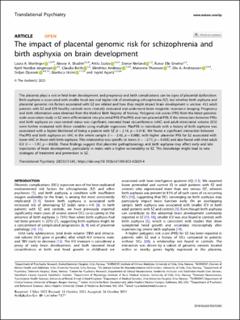| dc.contributor.author | Wortinger, Laura Anne | |
| dc.contributor.author | Shadrin, Alexey | |
| dc.contributor.author | Szabo, Attila | |
| dc.contributor.author | Nerland, Stener | |
| dc.contributor.author | Smelror, Runar | |
| dc.contributor.author | Jørgensen, Kjetil Nordbø | |
| dc.contributor.author | Barth, Claudia | |
| dc.contributor.author | Andreou, Dimitrios | |
| dc.contributor.author | Thoresen, Marianne | |
| dc.contributor.author | Andreassen, Ole | |
| dc.contributor.author | Djurovic, Srdjan | |
| dc.contributor.author | Ursini, Gianluca | |
| dc.contributor.author | Agartz, Ingrid | |
| dc.date.accessioned | 2024-04-17T11:06:19Z | |
| dc.date.available | 2024-04-17T11:06:19Z | |
| dc.date.created | 2023-11-10T10:23:55Z | |
| dc.date.issued | 2023 | |
| dc.identifier.issn | 2158-3188 | |
| dc.identifier.uri | https://hdl.handle.net/11250/3127001 | |
| dc.description.abstract | The placenta plays a role in fetal brain development, and pregnancy and birth complications can be signs of placental dysfunction. Birth asphyxia is associated with smaller head size and higher risk of developing schizophrenia (SZ), but whether birth asphyxia and placental genomic risk factors associated with SZ are related and how they might impact brain development is unclear. 433 adult patients with SZ and 870 healthy controls were clinically evaluated and underwent brain magnetic resonance imaging. Pregnancy and birth information were obtained from the Medical Birth Registry of Norway. Polygenic risk scores (PRS) from the latest genomewide association study in SZ were differentiated into placental PRS (PlacPRS) and non-placental PRS. If the interaction between PRSs and birth asphyxia on case-control status was significant, neonatal head circumference (nHC) and adult intracranial volume (ICV) were further evaluated with these variables using multiple regression. PlacPRS in individuals with a history of birth asphyxia was associated with a higher likelihood of being a patient with SZ (t = 2.10, p = 0.018). We found a significant interaction between PlacPRS and birth asphyxia on nHC in the whole sample (t = −2.43, p = 0.008), with higher placental PRS for SZ associated with lower nHC in those with birth asphyxia. This relationship was specific to males (t = −2.71, p = 0.005) and also found with their adult ICV (t = −1.97, p = 0.028). These findings suggest that placental pathophysiology and birth asphyxia may affect early and late trajectories of brain development, particularly in males with a higher vulnerability to SZ. This knowledge might lead to new strategies of treatment and prevention in SZ. | en_US |
| dc.language.iso | eng | en_US |
| dc.publisher | Nature | en_US |
| dc.rights | Navngivelse 4.0 Internasjonal | * |
| dc.rights.uri | http://creativecommons.org/licenses/by/4.0/deed.no | * |
| dc.title | The impact of placental genomic risk for schizophrenia and birth asphyxia on brain development | en_US |
| dc.type | Journal article | en_US |
| dc.type | Peer reviewed | en_US |
| dc.description.version | publishedVersion | en_US |
| dc.rights.holder | Copyright 2023 The Author(s) | en_US |
| dc.source.articlenumber | 343 | en_US |
| cristin.ispublished | true | |
| cristin.fulltext | original | |
| cristin.qualitycode | 1 | |
| dc.identifier.doi | 10.1038/s41398-023-02639-4 | |
| dc.identifier.cristin | 2194952 | |
| dc.source.journal | Translational Psychiatry | en_US |
| dc.relation.project | Helse Sør-Øst RHF: 2020-020 | en_US |
| dc.relation.project | Norges forskningsråd: 223273 | en_US |
| dc.identifier.citation | Translational Psychiatry. 2023, 13 (1), 343. | en_US |
| dc.source.volume | 13 | en_US |
| dc.source.issue | 1 | en_US |

